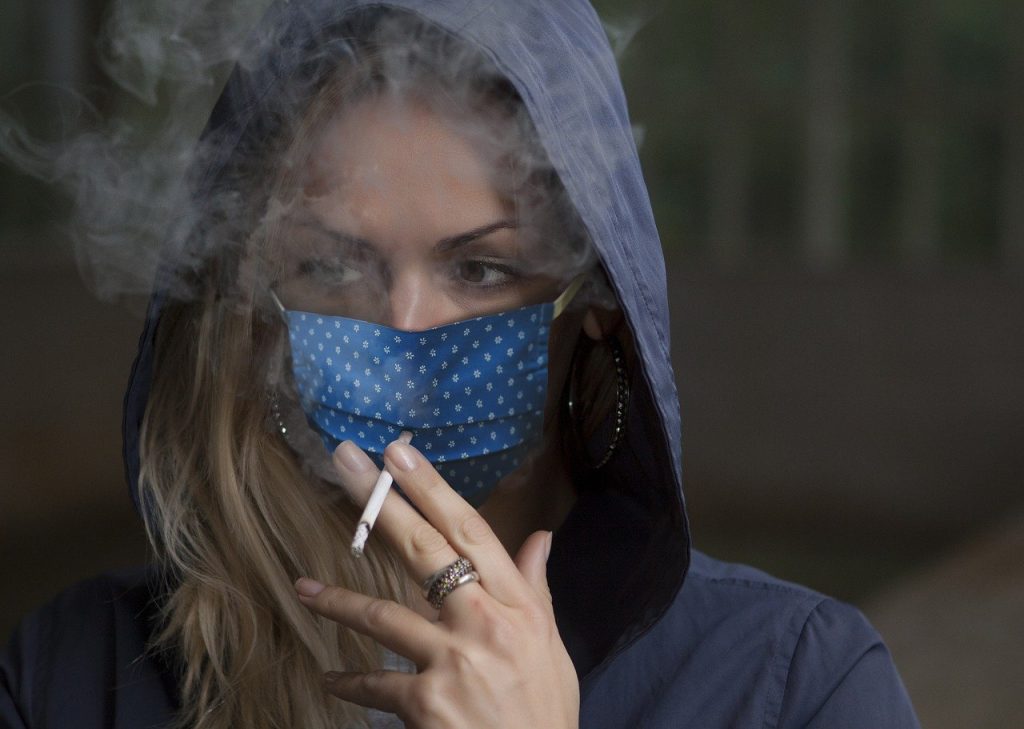
11721 Eastlight 62 EE (Earth Epic Calendar)
Soundtrack in my head: No Joy, “Hollywood Teeth”
I’ve read through the scientific studies on the COVID-19 vaccines. I’ve looked at infection rates on the national level, statewide level, and local level, and even in my own neighborhood. And I’ve talked with people who would be most affected by the latest CDC mask guidance: Frontline healthcare workers and people with chronic illness and weak immune systems. And after hearing their input and reviewing the scientific studies, I’ve come to this scientific conclusion: The CDC is smoking crack.
Readers of the New York Times, MSNBC watchers, and other good liberals of the world may take offense. This is science, they protest. To which I reply: It is more science-based than the hydroxychlorquine pushers (who deprived millions of autoimmune disease sufferers of a life-stabilizing drug). It is more science-based than the people who would have you believe that surgeons left and right have been passing out from lack of oxygen for over a hundred years. And it’s certainly more science-based than the idea of treating COVID by injecting disinfectants.
But I’m convinced that the science supporting this assertion is insufficient. I suspect that it’s actually politics and crude social engineering.
The CDC’s recommendation against masks, March 2020
Another classic example of the such crude social engineering was when the CDC mask guidance was to not wear masks in March 2020. They said that masks don’t help and that healthcare workers on the front line need them. The U.S. Surgeon General even chimed in and said “masks don’t work.” Which begged the question for anyone who was thinking critically at the time: why do healthcare workers need masks that don’t work? But then the CDC changed its tune in April saying that “new evidence” showed that masks in fact did work and began recommending “face coverings” (because apparently the M-word was too offensive to use in polite society).
The truth is that the evidence was already there. A University of Michigan study in 2007 confirmed it when tested on a normal flu season on campus. Dr. Raina McIntyre at the University of South Wales in Australia was also involved in a number of studies going back to 2010 establish the efficacy of masks. And yet another one from 2005 established the efficacy of face masks in preventing the wearer from spreading illness.
During the same month, a movement out of Europe, #Masks4All, began promoting the use of masks. In many parts of the world—including the U.S.–scores of volunteers were taking to their sewing machines and making masks. In the U.S., these volunteers were making them for healthcare workers. In the Czech Republic, people were making them for each other, and masking was a requirement. And they enjoyed a certain level of success. #Masks4All released a very effective video with a very simple tagline: “I protect you. You protect me.” The movement was successful enough to begin stimulating debate in the U.S., and the CDC mask guidance finally changed. They read the tea leaves and decided to recommend “face coverings.”
In June 2020, when pressed by an MSNBC why he and the CDC mask guidance initially recommended against masks, Dr. Fauci admitted that his main motivation for the March guidance was making sure there were enough masks for healthcare workers. Which means that the government’s claims about masks not being effective were lies.
Maybe Dr. Fauci thought he was doing the right thing . But there is another very disturbing question that arises from the “little white lie” told by the government in March 2020: How many lives could have been saved had the government recommended masks from the beginning? By April 3, 2020, when the CDC mask guidance changed to recommend face coverings, an average of 24,867 Americans were becoming infected with COVID-19 each day, had been reported infected, and an average of 810 people were dying of the virus were dying each day.
Politics seeping in at the local level
Even local health departments aren’t immune from undue influence. On May 13, 2020, the Wisconsin Supreme Court overturned Gov. Tony Evers’ “safer at home” orders. Immediately afterwards, Madison Mayor Satya Rhodes-Conway and Dane County Executive Joe Parisi said that the Dane County Department of Public Health would continue the “Badger Bounce” program that set specific benchmarks for loosening restrictions. These were designed to chart visible, noticeable, and most importantly, transparent ways of charting progress towards bringing infections down.
Yet two weeks later, I received a strange email from Dane County Public Health talking about easing COVID restrictions even though they acknowledged that other measures regarding the pandemic were climbing UP, not down. This was strange.
As it turned out, several alert Madison alders and Dane County Board members were also questioning the decision. Public Health responded by chastising them for raising questions at the last minute. A week later, news got out that the Greater Madison Chamber of Commerce Director Zach Brandon and the Mayor’s Office knew about these changes a week before they were released to the public. Why? Obviously some people were involved in discussions behind the scene. Somehow, the Chamber of Commerce was privy to discussions about public health decisions, but the elected Madison alders weren’t.
These kinds of shenanigans were happening all over the country, and we know the result: July reached new heights for infections, Dane County imposed a mask mandate effective July 13, 2020, and it has continued up to today.
May the face be with you

On May 13, 2021, the CDC mask guidance changed as they announced that vaccinated people no longer needed to wear masks outdoors or indoors. They acknowledged that it would be up to local health departments and businesses to determine whether and when to drop mask requirements. When asked the prospect of unvaccinated people not wearing masks in buildings, the CDC said that people were “on the honor system.”
We’ve seen how well that “honor system” has worked in the past. And recent Internet activity around fake CDC vaccine cards shows how well it’s working now. I had an incident recently in my apartment building where I took steps to distance myself from someone who’d never worn a mask at all in the previous year and he irritably said, “I’m fully vaccinated.” How much do you think I’m going to believe him? Vocal anti-maskers are now on social media talking about how they’re “vaccinated,” sometimes openly holding up the finger quotes while talking. So much for the “honor system.” It’s like giving a known thief the key to your house and then telling them that they’re on the honor system.
The CDC mask guidance has created a tidal wave of pressure to drop mask requirements. The mayor of Kansas City, Missouri revealed that after reviewing the infection rates in his city, he didn’t think it was a good idea to drop the mask mandate just yet—but after a wave of pressure from businesses and individuals, he felt forced to remove it.
This, of course, is very similar to a lot of pressure that has been pushed upon states, counties, municipalities throughout the pandemic. And it is a factor in the pandemic hurting the U.S. so much over the last 15 months.
The goalposts are moved. Again.

The science that is supposed to support the CDC mask guidance is based on findings that the vaccines are about 94-95% effective against the coronavirus. But that’s a huge window for infection nevertheless. What should people expect to happen when all the other barriers against the virus are suddenly removed?
And the Mayo Clinic website (as of May 23) says that some studies show that vaccines are less effective against COVID variants, but still effective in preventing severe COVID, though they also added the caveat that more research is needed.
As of May 23, an average of 344 new cases per day were being diagnosed in the state of Wisconsin. That’s the same rate of new cases as what existed in late June. I’ve analyzed state and county data, and it shows that over the last week, three people in my nine-square block census tract caught COVID last week. All of that is still pretty high.
Dr. Fauci had previously suggested that herd immunity would be achieved once between 70% and 85% of the population was vaccinated. As of May 23, 39% of the U.S. population is fully vaccinated. Even in Dane County, which has the highest national vaccination rate of all counties above 300,000 in population—is only at 57%.
More recent headlines suggested that herd immunity will be impossible and that the focus should be on containing local outbreaks. And some pundits are saying that vaccination is more important than herd immunity. Umm…wasn’t vaccination supposed to be a means to an end of achieving herd immunity?
Do I hear the sound of shuffling feet under the goalpost?
So let’s revisit why we were wearing masks in the first place. The idea was that all of us could potentially be carriers of COVID-19. We also knew that masks—except perhaps N95 respirators or stronger—were better at protecting other people than protecting ourselves. Like the Czech woman said, “I protect you, you protect me.”
So now, we have vaccines that will protect the person who has been vaccinated. It’s still an open question as to how long it will remain effective. It is less certain if it will keep people from spreading COVID-19. A friend of mine who is a nurse-practitioner recently told me they admitted someone who was vaccinated who tested positive for COVID. So it’s not 100% protective.
The mask hasn’t been our only protection, but next to isolation and social distancing, it was the most effective. And when the vaccines were first tested, no limitations were placed on the protective measures that test subjects could take. Which makes sense because such limitations would be unethical. The basis for saying that the vaccine is 90%+ effective is that the studies said there was that much of a difference in effectiveness, and they assumed that both the test and control groups were, in aggregate, protecting themselves the same.
But now we are moving from a test population of 30,000 to a test population of 330 million. Since the vaccine has never tested without additional protective measures, can they absolutely say with confidence that the vaccine will more than make up for the effectiveness of other measures?
The majority of 700+ epidemiologists surveyed by the New York Times questioned the wisdom of dropping the mask requirements.
Pride goeth before a fall. COVID overconfidence has embarrassed world governments before, such as India, and various countries in Europe.
Retail workers and the chronically ill thrown under the bus. Again.
The Washington Post just reported that infection rates among unvaccinated people are as high as they were in January in some places. One might argue that well, they’re bringing themselves that problem by not getting vaccinated. These bastards aren’t wearing masks, so that’s natural selection doing its thing, right?
Not so fast. The fact that so many unvaccinated people are also not wearing masks is a big part of the problem. And now they won’t be compelled to wear them in stores (though of course some businesses weren’t compelling them to do so anyway). So they’ll continue to spread the virus. What the CDC doesn’t seem to be taking into account is that it’s not just people who refuse to get vaccines who will be infected.
First, we have children. Up until recently, only people ages 16 and above were qualified to get the vaccine. Now children ages 12-15 are starting to get the Pfizer vaccine. But as school lets out for the summer, do you think kids will keep their masks on if their parents don’t? Has the CDC given even an iota of thought to what happens if you give everyone the impression that the pandemic is nearly over, except, um, for most kids? It’s true that on the whole COVID affects kids less severely, but that still means that a certain number of them can catch severe COVID.
So now you have vaccinated adults and most unvaccinated adults going maskless, and kids being told to keep their masks on. Good luck with that.

The 94-95% effectiveness rate doesn’t account for the fact that many people are far more exposed or at risk of COVID. What is a 5% risk for a cashier who deals with constant customers, one after another? Even if they continue to wear masks, most of the people they serve won’t be, and the people who never believed in masks or vaccinations so now they are more exposed than before. Thanks to the CDC.
I know there have been a lot of crybabies blubbering over the inconvenience of wearing a mask in the store for all of 5-20 minutes. Would it have been that hard to continue it for a few more weeks or months?
The 94-95% effectiveness rate also doesn’t account for the needs of people who have chronic illness. For some of them, the risks they face if they catch the virus are exponentially higher. Some have health conditions that make the vaccine risky. In any case, they now get to face an environment that is that much more risky as remaining mask requirements, as imperfect as they were, are now dropped.
Disabled people have often been especially marginalized by the COVID-19 pandemic. Ableism, endemic even prior to COVID-19, has taken especially ugly turns. When disabled people who were especially at risk told people they really needed them to wear masks, they were told they ought to stay home instead. Pandemic aid often didn’t include the disabled. At hospitals with shortages of ICU beds, triage procedures would often keep disabled from being treated due to “pre-existing conditions.” Throughout this year, in many states, disabled people and people with chronic illnesses got knocked to lower and lower places on priority lists. In Chicago, Mayor Lori Lightfoot explicitly refused to make disabled people a priority even when Illinois Governor J.B. Pritzker called for it. Looking at the statement made by Lightfoot on the issue, she chose not to even acknowledge their needs while talk about the needs of others. This kind of “forgetfulness,” unfortunately, is not an unusual phenomenon for disabled people to deal with. And now the CDC is forgetting them yet again.
What is really going on?

I have always thought that if we want to understand why people in power do irrational things, we should first look at how the money is flowing. I have already demonstrated how special interests have influenced government public health decisions all throughout this pandemic.
One possible motivation is that there are a lot of people in power who want to declare the pandemic over so that they can return to “normal.” The reasoning states that if there’s no pandemic, there’s no reason for people to hold back on their spending and no reason to hold back looking for a job. Right now, nothing says “the pandemic is over” like people shedding their masks.
Or maybe the CDC wants to take masks out of the equation to encourage more people to get the vaccine. If the vaccine is seen as the only viable way to protect against COVID-19, then perhaps more people will get it.
Maybe the pressure is coming from the Biden administration. They want to be the ones to have “defeated” the coronavirus. Gov. Greg Abbott of Texas used the repeal of the mask mandate to divert attention from a disastrous and embarrassing snow and ice disaster that made Texas GOP look like idiots.
There is a lot of money to be made off the perception that the pandemic is over. As such, there will always be pressure to sweep it under the rug in the hope that it goes away and stays away.
The point is that the CDC has not been above using its guidance to engage in crude social engineering. They did it in March 2020, and there’s reason to believe they are doing it again.
Managing the big gamble
Whatever the case may be, the 330 million residents of the United States are now part of a big social and epidemiological experiment.
I think there are two rational things to do in this brave new world. First, watch local infection statistics slowly. See if they continue to trend downward. And the other thing is to continue to use masks as long as the virus is above March 2020 levels.
ADDENDUM MAY 25 2021
Now THIS is fishy. At the beginning of May, twelve days before the CDC announced that vaccinated people don’t need to wear masks indoors or out, the CDC began to limit its monitoring of breakthrough COVID infections to severe cases only. Many scientists criticize this decision because they feel that as much information on breakthough COVID infections is needed in the case of variants. For example, the B.1.617.2 COVID variant that is devastating India right now expected to take over in Britain, where it is twice as virulent as the B.1.1.7 variant that dominated Britain and now dominates the US, and that British variant is twice as virulent as the original coronavirus that spread around the world.
And why is it that this reduction of monitoring occurred right before the CDC de facto ended all mask requirements? As I said before, the CDC is now suddenly subjecting the entire U.S. to an experiment in which the vaccines are tested without being accompanied by other protective measures. Many epidemiologists have argued it would be better to phase out measures like masks and social distancing more slowly.
Just in case anyone is wondering, I got my second Moderna vaccine last week, and I’m a few days away from being considered fully vaccinated. I’m not “anti-vaccine” though I think healthy skepticism is in order with newer vaccines put out on the market.
All I can say is that the CDC had better be right about the vaccine being as effective as it is. Or else the entire country will have hell to pay. For now, I’m keeping that mask on.

2 thoughts on “latest CDC mask guidance: are they smoking crack?”